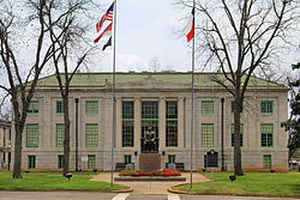Texas Counties
Texas is divided into two hundred and fifty-four counties, more than any other state. Texas was originally divided into municipalities, a unit of local government under Spanish and Mexican rule. When the Republic of Texas gained its independence in 1836, there were 23 municipalities, which became the original Texas counties. Many of these would later be divided into new counties. The most recent county to be created was Kenedy County in 1921. The most recent county to be organized was Loving County in 1931San Augustine County, Texas
San Augustine County Education, Geography, and History

San Augustine County is a county located in the state of Texas. Based on the 2010 census, its population was 8,865. Its county seat is San Augustine
Etymology - Origin of San Augustine County Name
It was supposedly named after the Saint, Augustine of Hippo. However, it seems plausible
that the county was named for the town of San Augustine, which had been established five years earlier and whose name was based upon an
18th-century Spanish presidio (fortress).
Demographics:
County QuickFacts: CensusBureau Quick Facts
San Augustine County History
San Augustine County was formed in 1837. It was supposedly named after the Saint, Augustine of Hippo. However, it seems plausible that the county was named for the town of San Augustine, which had been established five years earlier and whose name was based upon an 18th-century Spanish presidio (fortress). Its county seat is San Augustine.
Handbook of Texas Online
Unrest still plagued the new district, however. Ayish Bayou settlers had been involved in
the 1832 battle of Nacogdoches, in which they helped remove Jos?de las Piedras,
commandant of Nacogdoches. Subsequently, they sent prominent representatives, including Sam Houston
in 1833, to the conventions of 1832 and 1833. Early in 1836 Houston was elected
commander of the Texian forces at San Augustine-and then for all of Texas-which took an active part in the Texas
Revolution. In April the town was abandoned when citizens fled toward the
Louisiana border in the Runaway Scrape. They returned to their homes with news
of the victory at the battle of San Jacinto. With the close of hostilities,
Texans began establishing a government for the new Republic of Texas. San
Augustine County was one of the first counties to be formed. In 1837 settlers chose county officials, including a
chief justice, a county clerk, a sheriff, a district clerk, a surveyor, and a coroner. In most instances, war heroes
were elected to those positions, replacing earlier settlers as community leaders. More at
Vista K. McCroskey, "SAN AUGUSTINE COUNTY," Handbook of Texas Online (http://www.tshaonline.org/handbook/online/articles/hcs02),
accessed January 24, 2016. Uploaded on June 15, 2010. Published by the Texas State Historical Association.
Geography: Land and Water
As reported by the Census Bureau, the county has a total area of 592 square miles (1,534 km2), of which, 528
square miles (1,367 km2) of it is land and 64 square miles (167 km2) of it (10.86%) is water.
Neighboring Counties
Bordering counties are as follows:
- Shelby County (north)
- Sabine County (east)
- Jasper County (south)
- Angelina County (southwest)
- Nacogdoches County (west)
Education







